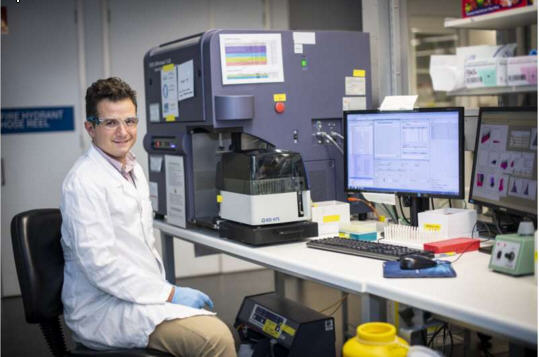博文
发现凸显了一线免疫细胞的复杂生活方式
||
发现凸显了一线免疫细胞的复杂生活方式
诸平

WEHI researcher Dr Michael Chopin have made a surprise discovery about how immune ‘sentinel’ cells are maintained, which could have implications for drugs in development for treating cancer. Credit: WEHI
据沃尔特和伊丽莎·霍尔研究所(Walter and Eliza Hall Institute简称WEHI)2021年9月18日提供的消息,WEHI的研究人员在免疫“前哨”细胞(immune 'sentinel' cells)如何维持方面有了惊人的发现(Discovery highlights the complex lifestyles of frontline immune cells),这可能对正在开发的癌症治疗药物有意义。
研究人员研究了删除免疫细胞中负责控制细胞沉默或关闭基因能力的特定蛋白质的影响。他们惊讶地发现,“前哨”免疫细胞('sentinel' immune cells)的一个组成部分被删除后,会受到影响,导致这些细胞从皮肤和肺部完全消失。这表明,抑制这种成分的药物治疗疾病,如癌症,可能会对免疫系统产生意想不到的后果。
该研究由詹逸凡博士(Dr. Yifan Zhan音译)、张玉霞博士(Dr. Yuxia Zhang)、张晟波先生(Mr Shengbo Zhang)、米迦勒·肖邦(Michaël Chopin)博士、斯蒂芬·纳特(Stephen Nutt)教授等领导,于2021年9月17日已经在《科学免疫学》(Science Immunology)杂志网站发表——Yifan Zhan, Yuxia Zhang, Shengbo Zhang, Hannah Coughlan, Pedro L. Baldoni, Nicolas Jacquelot, Wang H. J. Cao, Simon Preston, Cynthia Louis, Jai Rautela, Marc Pellegrini, Ian P. Wicks, Warren S. Alexander, Leonard C. Harrison, Andrew M. Lew, Gordon K. Smyth, Stephen L. Nutt, Michaël Chopin. Differential requirement for the Polycomb repressor complex 2 in dendritic cell and tissue-resident myeloid cell homeostasis. Science Immunology, 17 Sep 2021, Vol 6, Issue 63. DOI: 10.1126/sciimmunol.abf7268. https://doi.org/10.1126/sciimmunol.abf7268
一个错综复杂的问题(A complex issue)
该研究小组研究了多梳抑制复合物2 (polycomb suppression complex 2简称PRC2)在一线应答免疫细胞中的作用。
米迦勒·肖邦(Michaël Chopin)博士说,PRC2负责“关闭”基因,包括免疫细胞中的基因,而免疫细胞对维持基因数量和正常功能至关重要。他说:“我们的实验室研究基因调控,也就是细胞内控制我们DNA编码的基因如何以及何时被使用的分子过程。我们研究了PRC2在两种免疫细胞群中的功能,这两种细胞群构成了抵御感染的第一道防线。这些细胞为外部环境提供了重要的免疫屏障,保护皮肤和肺部免受微生物的侵袭。”
该研究小组移除了此复合物的两种组成部分,一种叫做EZH2的酶和一种叫做Suz12的结构蛋白,以观察它是如何影响免疫细胞的发育、种群和功能的。删除EZH2对两个细胞群的生物学和功能均无影响,细胞仍能有效应对病毒感染。
米迦勒·肖邦博士说:“我们惊讶地发现,删除EZH2后,免疫细胞基本不受影响。”
相反,当Suz12被删除后,某些巨噬细胞(macrophages),比如那些驻留在我们皮肤和肺部的巨噬细胞,就完全消失了。米迦勒·肖邦博士说:“这些寄生在组织中的巨噬细胞负责检测和清除身体中各种渗透的细菌(infiltrating bacteria)和病毒感染的细胞(virus-infected cells),并通过刺激炎症信号的产生来提醒身体受到攻击。驻留在组织中的巨噬细胞具有独特的特性,能够在整个成年期独立地维持其数量。我们的研究强调了Suz12和PRC2在控制这些免疫细胞的调节程序中的关键作用。”
无法预料的影响(Unexpected effects)
斯蒂芬·纳特(Stephen L. Nutt)教授说,重要的是要了解药物干扰关闭基因的蛋白质的潜在连锁反应。“PRC2与许多癌症有关,比如淋巴瘤(lymphoma)。世界各地正在开展重要的工作,以开发针对该复合体成分的药物来治疗癌症。”他说,至少有一种已被批准用于治疗一种罕见肉瘤(sarcoma)的药物,含有抑制这种复合物的成分。“我们需要更深入地研究抑制EZH2和Suz12功能的药物是否会对免疫系统产生意想不到的后果。”
另一方面,斯蒂芬·纳特教授说,了解存在哪些冗余可能会阻止药物达到预期效果也很重要。“目前的看法是,抑制EZH2将抑制免疫反应,例如,如果你想治疗免疫或炎症疾病。我们的研究表明,至少对于这些在感染早期活跃并触发免疫系统其他元素的特定前线免疫细胞来说,情况不太可能如此。”
斯蒂芬·纳特教授表示,该研究是该团队更广泛关注分子水平上的基因调控(gene regulation )的一部分。他说:“我们体内细胞的正常功能依赖于每个细胞在正确的时间、正确的位置使用我们DNA中数万个基因的适当组合的能力。阻止基因被利用的分子控制对生命至关重要。”上述介绍,仅供参考。欲了解更多信息,敬请注意浏览原文或者相关报道。
Unravelling the secret of a critical immune cell for cancer immunity
Parsing Polycomb in myeloid cells
The Polycomb repressive complex 2 (PRC2) is responsible for trimethylation of histone H3 on lysine-27 (H3K27me3), an epigenetic modification associated with transcriptional repression. The activity of PRC2 is dysregulated in certain cancers, but its function in myeloid cell development is not known. Using mice with myeloid-specific genetic deletion of core PRC2 proteins, Zhan et al. demonstrate a selective requirement for PRC2 activity in tissue-resident macrophages but not dendritic cells (DCs). Whereas activity of the EZH2 methyltransferase was broadly dispensable for myeloid cell homeostasis, PRC2 activity was essential for maintaining alveolar macrophage self-renewal by regulating expression of cell cycle and DNA replication genes. These results demonstrate a dichotomy in myeloid cell reliance on PRC2, highlighting differences in the epigenetic mechanisms regulating DC and macrophage homeostasis.
Dendritic cells (DCs) and macrophages are at the forefront of immune responses, modifying their transcriptional programs in response to their tissue environment or immunological challenge. Posttranslational modifications of histones, such as histone H3 lysine-27 trimethylation (H3K27me3) by the Polycomb repressive complex 2 (PRC2), are tightly associated with epigenetic regulation of gene expression. To explore whether H3K27me3 is involved in either the establishment or function of the mononuclear phagocyte system, we selectively deleted core components of PRC2, either EZH2 or SUZ12, in CD11c-expressing myeloid cells. Unexpectedly, EZH2 deficiency neither prevented the deposition and maintenance of H3K27me3 in DCs nor hindered DC/macrophage homeostasis. In contrast, SUZ12 deficiency markedly impaired the capacity of DCs and macrophages to maintain H3K27me3. SUZ12 ablation induced a rapid loss of the alveolar macrophage and Langerhans cell networks under both steady state and inflammatory conditions because these cells could no longer proliferate to facilitate their self-renewal. Despite the reduced H3K27me3, DC development and function were unaffected by SUZ12 ablation, suggesting that PRC2-mediated gene repression was dispensable for DC homeostasis. Thus, the role of SUZ12 highlights the fundamentally different homeostatic mechanisms used by tissue-resident myeloid cells versus DCs.
https://blog.sciencenet.cn/blog-212210-1304865.html
上一篇:澳中科学家:清洁制氢的游戏规则改变者
下一篇:超薄自愈合聚合物创造了新的、可持续的防水涂层